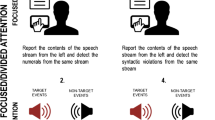Abstract
A technique is presented for the measurement of fluctuations in processing demands during spontaneous speech. The technique consists of the analysis of errors on a secondary tracking task. Data are presented from illustrative samples of spontaneous speech; thus, evidence was found to suggest that one level of planning in speech is clauses that contain a single main verb. Evidence was also obtained that there is an increase in processing demands at the gap in subject relative and object relative clauses. It is concluded that the secondary tracking task is a useful technique that could be extended to studies of reading and speech comprehension.
Similar content being viewed by others
References
Allport, D.A. (1980). Attention and performance. In G. Claxton (Ed.),Cognitive psychology: New directions. London: Routledge and Kegan Paul.
Allport, D.A., Antonis, B., & Reynolds, P. (1972). On the division of attention: A disproof or the single channel hypothesis.Quarterly Journal of Experimental Psychology, 24, 225–235.
Beattie, G. (1983).Talk: An analysis of speech and non-verbal behaviour in conversation. Milton Keynes: Open University Press.
Brotherton, P. (1979). Speaking and not speaking: Processes for translating ideas into speech. In A. Siegman & S. Feldstein (Eds.),Of time and speech. Hillsdale, New Jersey: Erlbaum.
Butterworth, B. (1975). Hesitation and semantic planning in speech.Journal of Psycholinguistic Research, 4, 75–87.
Butterworth, B. (1980). Evidence from pauses in speech. In B. Butterworth (Ed.),Language production, Vol.1: Speech and talk. New York: Academic Press.
Butterworth, B., & Beattie, G.W. (1978). Gesture and silence as indicators of planning in speech. In R.N. Campbell & P.T. Smith (Eds.),Recent advances in the psychology of language: Formal and experimental approaches. New York: Plenum Press.
Cole, R.A. (1973). Listening for mispronunciations: A measure of what we hear during speech.Perception and Psychophysics, 14, 153–156.
Eysenck, M.W. (1984).A handbook of cognitive psychology, Hillsdale, New Jersey: Erlbaum.
Fay, D. (1979). Performing transformations. In R. Cole (Ed.),Perception and production of fluent speech. Hillsdale, New Jersey: Erlbaum.
Fodor, J.A., Bever, T.G., & Garrett, M.F. (1974).The psychology of language: An introduction to psycholinguistics and generative grammar. New York: McGraw-Hill.
Ford, M. (1980).Sentence planning units: Implications for the speaker's representation of meaningful relations underlying sentences. Unpublished manuscript, MIT.
Ford, M. (1983). A method for obtaining measures of local parsing complexity throughout sentences.Journal of Verbal Learning and Verbal Behavior, 22, 203–218.
Ford, M., & Holmes, V.M. (1978). Planning units and syntax in sentence production.Cognition, 6, 35–53.
Frazier, L., Clifton, C., & Randall, J. (1983). Filling gaps: Decision principles and structure in sentence comprehension.Cognition, 13, 187–222.
Garrett, M.F. (1976). Syntactic processes in sentence production. In E. Walker & R. Wales (Eds.),New approaches to language mechanisms. Amsterdam: North-Holland.
Garrett, M.F. (1980). Levels of processing in sentence production. In B. Butterworth (Ed.),Language production, Vol.1: Speech and talk. New York: Academic Press.
Hirst, W., Spelke, E.S., Reaves, C.C., Caharack, G., & Neisser, U. (1980). Dividing attention without alternation and automaticity.Journal of Experimental Psychology: General, 109, 98–117.
Johnson-Laird, P.N. (1977). Psycholinguistics without linguistics. In N.S. Sutherland (Ed.),Tutorial essays in psychology (Vol.1). New York: Erlbaum.
Johnson-Laird, P.N. (1980 June).Propositional representation. Procedural semantics—Mental model. Paper presented at the CNRS Conference, Royaumont.
Kowal, S.H., & O'Connell, D.C. (1985). Cognitive rhythms reluctantly revisited.Language and Speech, 28, 93–95.
Levelt, W.J.M. (1981, March 11–12).The speakers' linearization problem. Paper presented at the Royal Society/British Academy discussion meeting on the psychological mechanisms of language.
Levelt, W.J.M. (1983). Monitoring and self-repair in speech.Cognition, 14, 41–104.
McLeod, P. (1977). A dual task response modality effect: Support for multiprocessor models of attention.Quarterly Journal of Experimental Psychology, 29, 651–667.
Norman, D.A., & Bobrow, D.G. (1975). On data-limited and resource-limited processes.Cognitive Psychology, 7, 44–64.
Poulton, E.C. (1969). Tracking. In E.A. Bilodeau (Ed.),Principles of skill acquisition. New York: Academic Press.
Power, M.J. (1981).An experimental investigation of spontaneous speech. Unpublished doctoral dissertation, University of Sussex.
Power, M.J. (1983). Are there cognitive rhythms in speech?Language and Speech, 26, 253–261.
Power, M.J. (1984). Are there cognitive rhythms in speech?—A reply to Beattie (1984).Language and Speech, 27, 197–201.
Power, M.J. (1985). Sentence production and working memory.Quarterly Journal of Experimental Psychology, 37A, 367–385.
Shaffer, L.H. (1975). Multiple attention in continuous verbal tasks. In P.M.A. Rabbit & S. Dornic (Eds.),Attention and performance (Vol.V). London: Academic Press.
Shiffrin, R.M., & Schneider, W. (1984). Automatic and controlled processing revisited.Psychological Review, 91, 269–276.
Spelke, E., Hirst, W., & Neisser, U. (1976). Skills of divided attention.Cognition, 4, 215–230.
Trumbo, D., Noble, M., & Swink, J. (1967). Secondary task interference in the performance of tracking tasks.Journal of Experimental Psychology, 73, 232–240.
Valian, V.V. (1971).Talking, listening, and linguistic structure. Unpublished doctoral dissertation, North Eastern University.
Wanner, E., & Maratsos, M. (1978). An ATN approach to comprehension. In M. Halle, J. Bresnan, & G.A. Miller (Eds.),Linguistic theory and psychological reality, Cambridge, Massachusetts: MIT Press.
Author information
Authors and Affiliations
Rights and permissions
About this article
Cite this article
Power, M.J. A technique for measuring processing load during speech production. J Psycholinguist Res 15, 371–382 (1986). https://doi.org/10.1007/BF01067720
Accepted:
Issue Date:
DOI: https://doi.org/10.1007/BF01067720




